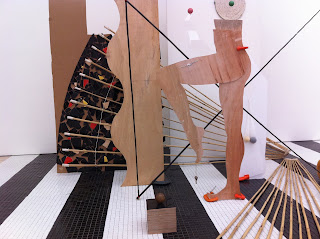The tremors of bass that reverberated through the Serpentine Gallery prior to the show were telling of things to come. Likened to the romping thuds of an imminent T-Rex in Jurassic Park, it was what we could hear and feel, rather than what we could see, that sparked a wave of excitable conversation (though it’s a shame we didn't have bowls of Jell-O with us).

Set in the domed central room of the Serpentine Gallery in Hyde Park, 2008 Turner Prize winning artist Mark Leckey performs BigBoxActionStatue (2003-2011). It primarily consists of two towering structures opposing one another in a stubborn standoff. The first is a tall languorous bronze sculpture whose soft undulations and weathered patina assure us that we are, in fact, observing a Henry Moore (Upright Motive No. 9 - 1979). Opposite is a gargantuan block of wood and electronics - a stacked speaker system decked with an array of speaks that allow for earpiercing highs and heart-shaking bass – all of which is tested by thirty minutes of recordings. Then there is a ring of roughly 50 onlookers who often find their attention meandering across the room to observe another's reaction. But where most darting eyes manage to rest is on Mark Leckey, who, standing beside the speakerblock like a faithful sidekick, stares meaningfully at the head of the anthropomorphic bronze with such certainty that one is sure that SOMEthing is bound to happen at any moment.
Disappointingly perhaps, the sculpture never bursts out from its shell (at least not at this performance). But the effect of Mark's posturing and occasional vocals is one of a deep contemplation - lack of movement means a greater focus upon the incredible and incessant array of sounds that attempt to prize a reaction out of this obstinate sculpture - kind of like getting your grandmother to admit there's sense to be found in Tracy Emin’s My Bed.
Sounds from the speakerbox range from rhythmic beats to Leckey’s chants to, more often than not, untamed noise, all testing the highs and lows of the speakers' capabilities, and entail a search through a parsed variety of musical genres (80s synth to classical and choir) and emotional crescendos. And though our subjects are motionless, it is this amalgamation of sound that provides one with food for thought, inspiring tentative possibilities, all surrounding this conversation, or rather monologue, between speaker and sculpture, contemporary and traditional, vocal and mute, industrial and natural. Not only does the sound develop within us a strong desire to see the Moore react, but we also see the speakerblock change from a utility for entertainment - one representative of our most heady nights - to a provocative tool of debate. The subtle guidance of Leckey the maestro doesn't just coax the Moore into a modern life, but also adds a new dimension, and a greater purpose, to the commonplace soundsystem. In a strange sense, this is the transformation and celebration of the individuality of the speakerbox.
Hmm, maybe that's a bit rich. The point is, with BigBoxActionStatue, Mark Leckey has created a catalyst for imagination. He sparks your thought process into a world of improbabilities that, at least while you’re still in the Serpentine, seems perfectly sane. It is why you entertain the idea of the Henry Moore raising its arms and bellowing back at the speakers. It is why, when a woman faints in the middle of the performance you wonder if she is just the first of many who are collectively experiencing some spiritual revelation that climaxes with a thud on the floor. It is why this performance is worthwhile.
Remaining BigBoxActionStatue performance dates: Thurs. June 9th @ 7pm; Thurs. June 16th @ 7pm Performances are free though booking is essential – RSVP information@serpentinegallery.orgBigBoxActionStatue at the Serpentine Gallery is part of the Mark Leckey exhibition SEE, WE ASSEMBLE that runs until June 26th, 2011
Closest tube: From south of Hyde Park - South Kensington, Knightsbridge; From north of Hyde Park - Lancaster Gate, Queensway;
Photo Credit: Mark Blower, www.serpentinegallery.org
Special thanks to Charlotte McGuinness





